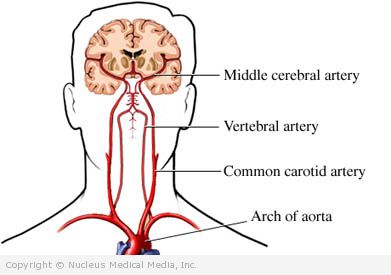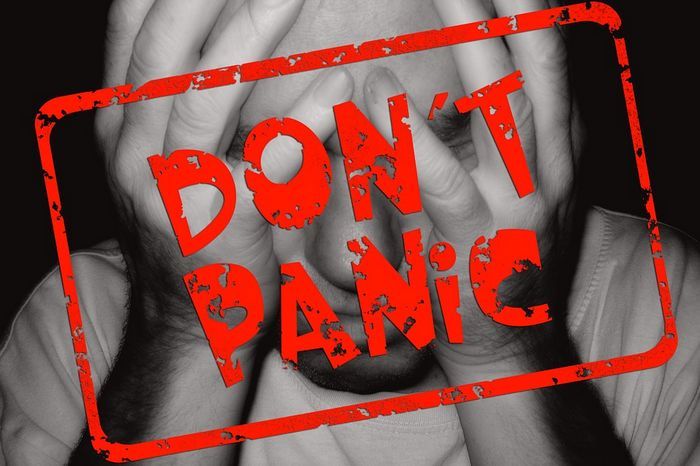Transient Ischemic Attack
(TIA; Mini-Stroke)
Transient ischemic attack – Definition
Transient ischemic attack (TIA) is a temporary dysfunction of the brain due to a shortage of blood and oxygen. A TIA lasts no longer than 24 hours. It is sometimes referred to as a mini-stroke.
TIA is a serious condition. It serves as a warning for a potential stroke. About 30% of stroke patients have had a TIA at some point in the past.
Transient ischemic attack – Causes
Blood and oxygen are carried to the brain through major blood vessels in the neck. The blood then passes through a series of blood vessels in the brain. A TIA occurs when the blood flow through the neck or brain vessels is reduced. The blood flow may be reduced by a narrowing or blockage of the blood vessels.
Narrowing of the blood vessels may occur with:
- Build up of plaque in the blood vessels, called atherosclerosis
- Vasculitis — swelling of the blood vessels
Blood vessels can also become blocked or obstructed by a clot or clump that is floating in the blood. This may be caused by:
- A piece of blood clot or plaque that has broken off of another location
- Blood and blood-clotting disorders such as:
- Anemia (too few red blood cells)
- Polycythemia (too many red blood cells)
- Hyperviscosity (abnormal thickening of the blood)
- Endocarditis (infection of the lining of the heart)
Transient ischemic attack – Risk Factors
Certain chronic medical conditions can affect the health of your blood vessels. The following condition may increase your chance or cause TIA:
- High blood pressure
- Diabetes
- Atrial fibrillation.
Other factors that increase your chance for TIA include:
- Family history of stroke
- Age: 45 years or older (highest risk 60-80 years of age); more common in men than women in younger age groups
- Smoking
- Excessive alcohol use
- High cholesterol
- Obesity
- Certain medical conditions:
- Heart disease
- Sleep apnea
- AIDS
Transient ischemic attack – Symptoms
TIA symptoms occur abruptly. They usually last less than 10 minutes or they may persist for up to 24 hours. The symptoms are different depending on the part of the brain that is affected. TIA symptoms are similar to those of a stroke and need immediate medical attention.
Symptoms may include:
- Blindness in one eye, often described as a window shade dropping, and/or other visual problems
- Weakness, numbness, or tingling of the face, arm, leg, or one side of the body (usually affects one side of the body, but there are exceptions).
- Difficulty speaking or understanding words
- Dizziness, unsteadiness of gait, or falling
- Trouble with balance or coordination
- Loss of consciousness
- Nausea
- Vomiting
- Sudden confusion or loss of memory
Transient ischemic attack – Diagnosis
The doctor will ask about your symptoms and medial history. A physical exam will be done. Your doctor will carefully assess your blood pressure and nervous system. The main goal of tests or questions will be to determine your stroke risk.
Tests may include:
- Blood tests — such as a complete blood count, blood sugar (glucose), cholesterol and other fat levels, clotting factors, and a check of other elements in the blood
- Electrocardiogram (ECG) — to measure heart rhythm (which would be irregular in, for example, atrial fibrillation) and check for other signs of heart disease
- Doppler ultrasound — a test that uses sound waves to help determine if there is compromised blood flow in the arteries supplying the brain
- Echocardiogram — another ultrasound test to look for blood clots and valve abnormalities within the heart
- Computed tomography (CT) scan of the head — a type of x-ray that uses a computer to create images of structures inside the head; in this case, to look for evidence of bleeding or other damage to the brain
- CT angiogram (CTA) — a CT scan which uses dye to evaluate the blood vessels in the brain and neck.
- Magnetic resonance imaging (MRI) scan of the head — a test that uses powerful magnetic radio waves to create images of structures inside the head; in this case, to look for evidence of bleeding or other damage to the brain
- Magnetic resonance angiography (MRA) — a study of the blood vessels using MRI, creating two-dimensional and three-dimensional pictures.
- Arteriogram /angiogram — a test in which contrast dye is injected into selected arteries and x-ray images are produced to precisely locate the blockage or narrowing and to determine its extent
- Electroencephalogram (EEG) — a test that can detect the presence of seizures by measuring brain waves (used only if a seizure is suspected)
Transient ischemic attack – Treatment
A TIA places you at greater risk for having a stroke. The risk is actually highest in the first week after your TIA. Therefore, rapid treatment aims to decrease your risk of stroke. This can be done with lifestyle changes, medicine, and surgery.
Lifestyle
Smokers must quit.
Patient with diabetes, hypertension, and/or high cholesterol must make every effort to manage these conditions. It can be done with:
- Regular exercise — discuss this with your doctor first
- Appropriate dietary changes — low in saturated fat and rich in whole grains, fruits, and vegetables
- Other lifestyle interventions
Medications
The doctor may also prescribe medicine to lower blood sugar, blood pressure, and cholesterol. This will help lower these risk factors. To decrease the risk of clot formation your doctor may recommend:
- Aspirin
- Clopidogrel
- Dipyridamole
- Coumadin
- Dabigatran
Surgery
If you have at least a 70% blockage in your carotid artery (in your neck), doctors may recommend:
- A carotid endarterectomy — to remove the plaque deposits
- Other less invasive procedures such as (intra-arterial stenting)
These procedures have risks associated with them. Talk to your doctor about your options. They are often not done if there are no symptoms and less than 70% blockage.
Treatment of Underlying Conditions
If the cause of the TIA is a treatable condition, it must be promptly treated. Specific conditions that need further treatment include:
- Atrial fibrillation
- Severe anemia
- Vasculitis
Transient ischemic attack – Prevention
The following strategies may help reduce the chance of TIAs and stroke:
- Exercise regularly, with your doctor’s approval.
- Eat a healthful diet. It should be low in saturated fat and rich in whole grains, fruits, and vegetables.
- Maintain a healthy weight.
- If you smoke, quit.
- Drink alcohol in moderation. Moderate alcohol intake is no more than two drinks per day for men and one drink per day for women.
- Control blood pressure, high cholesterol, and diabetes with medicines as needed.




